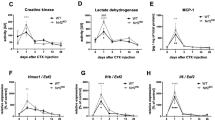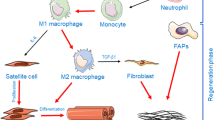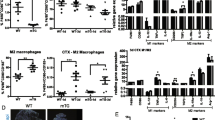Abstract
To improve muscle healing upon injury, it is of importance to understand the interplay of key signaling pathways during muscle regeneration. To study this, mice were injected with cardiotoxin (CTX) or PBS in the Tibialis Anterior muscle and were sacrificed 2, 5 and 12 days upon injection. The time points represent different phases of the regeneration process, i.e. destruction, repair and remodeling, respectively. Two days upon CTX-injection, p-mTORC1 signaling and stress markers such as BiP and p-ERK1/2 were upregulated. Phospho-ERK1/2 and p-mTORC1 peaked at d5, while BiP expression decreased towards PBS levels. Phospho-FOXO decreased 2 and 5 days following CTX-injection, indicative of an increase in catabolic signaling. Furthermore, CTX-injection induced a shift in the fiber type composition, characterized by an initial loss in type IIa fibers at d2 and at d5. At d5, new type IIb fibers appeared, whereas type IIa fibers were recovered at d12. To conclude, CTX-injection severely affected key modulators of muscle metabolism and histology. These data provide useful information for the development of strategies that aim to improve muscle molecular signaling and thereby recovery.





Similar content being viewed by others
Data availability
Data are presented in figures and tables.
References
Bohnert KR, Mcmillan JD, Kumar A (2018) Emerging roles of ER stress and unfolded protein response pathways in skeletal muscle health and disease. J Cell Physiol 233:67–78. https://doi.org/10.1002/jcp.25852
Brocca L, Toniolo L, Reggiani C et al (2017) FoxO-dependent atrogenes vary among catabolic conditions and play a key role in muscle atrophy induced by hindlimb suspension. J Physiol 595:1143–1158. https://doi.org/10.1113/JP273097
Bröer S, Bröer A (2017) Amino acid homeostasis and signalling in mammalian cells and organisms. Biochem J 474:1935–1963. https://doi.org/10.1042/BCJ20160822
Cho H, Choi SH, Hwang K et al (2005) Molecules and the Src/PLC/PKC/MEK/ERK signaling pathway is involved in aortic smooth muscle cell proliferation induced by glycated LDL. Mol Cells 19:60–66
Cho Y, Yao K, Bode AM et al (2007) RSK2 mediates muscle cell differentiation through regulation of NFAT3. J Biol Chem 282:8380–8392. https://doi.org/10.1074/jbc.M611322200
Conus NM, Hemmings BA, Pearson RB (1998) Differential regulation by calcium reveals distinct signaling requirements for the activation of Akt and p70 S6k *. J Biol Chem 273:4776–4782
Couteaux R, Mira J-C, D’Albis A (1988) Regeneration of muscles after cardiotoxin injury I. Cytological aspects. Biol Cell 62:171–182
Czerwinska AM, Streminska W, Ciemerych MA, Grabowska I (2012) Mouse gastrocnemius muscle regeneration after mechanical or cardiotoxin injury. Folia Histochem Cytobiol 50:144–153. https://doi.org/10.5603/FHC.2012.0021
D’Albis A, Couteaux R, Janmot C et al (1988) Regeneration after cardiotoxin injury of innervated and denervated slow and fast muscles of mammals. Eur J Biochem 174:103–110
Erbay E, Park I, Nuzzi PD et al (2003) IGF-II transcription in skeletal myogenesis is controlled by mTOR and nutrients. J Cell Biol 163:931–936. https://doi.org/10.1083/jcb.200307158
Fan Q, Cheng C, Knight ZA et al (2009) EGFR signals to mTOR through PKC and independently of Akt in glioma. Sci Signal 2:ra4
Filippa N, Sable CL, Filloux C et al (1999) Mechanism of protein kinase B activation by cyclic AMP-dependent protein kinase. Mol Cell Biol 19:4989–5000
Fink E, Fortin D, Serrurier B et al (2003) Recovery of contractile and metabolic phenotypes in regenerating slow muscle after notexin-induced or crush injury. J Muscle Res Cell Motil 24:421–429. https://doi.org/10.1023/A:1027387501614
Ge Y, Wu A, Warnes C et al (2009) mTOR regulates skeletal muscle regeneration in vivo through kinase-dependent and kinase-independent mechanisms. Am J Physiol Cell Physiol 297:1434–1444. https://doi.org/10.1152/ajpcell.00248.2009
Gething M (1999) Role and regulation of the ER chaperone BiP. Semin Cell Dev Biol 10:465–472
Goetsch SC, Hawke TJ, Gallardo TD et al (2003) Transcriptional profiling and regulation of the extracellular matrix during muscle regeneration. Physiol Genomics 14:261–271
Goldspink BDF (1976) The effects of denervation on protein turnover of rat skeletal muscle. Biochem J 156:71–80
Goldspink DF (1978) Changes in the size and protein turnover of the Soleus muscle in response to immobilization or denervation. Biochem Soc Trans 6:1014–1017
Goldspink DF, Garlickt PJ, Mcnurlanti MA (1983) Protein turnover measured in vivo and in vitro in muscles undergoing compensatory growth and subsequent denervation atrophy. Biochem J 210:89–98
Graves LM, He Y, Lambert J et al (1997) An intracellular calcium signal activates p70 but not p90 ribosomal S6 kinase in liver epithelial cells. J Biol Chem 272:1920–1928
Gulati P, Gaspers LD, Dann SG et al (2008) Article amino acids activate mTOR complex 1 via Ca2+/CaM signaling to hVps34. Cell Metab 4:456–465. https://doi.org/10.1016/j.cmet.2008.03.002
Harris JB (2003) Myotoxic phospholipases A2 and the regeneration of skeletal muscles. Toxicon 42:933–945. https://doi.org/10.1016/j.toxicon.2003.11.011
Harvey A, Marshall R, Karlsson E (1982) Effects of purified cardiotoxins from the Thailand cobra (Naja naja siamensis) on isolated skeletal and cardiac muscle preparations. Toxicon 20:379–396
Iijima Y, Laser M, Shiraishi H et al (2002) c-Raf/MEK/ERK pathway controls protein kinase C-mediated p70S6K activation in adult cardiac muscle cells. J Biol Chem 277:23065–23075. https://doi.org/10.1074/jbc.M200328200
Järvinen TAH, Järvinen TLN, Kääriäinen M et al (2005) Muscle injuries: biology and treatment. Am J Sport Med 33:745–764. https://doi.org/10.1177/0363546505274714
Jerkovic R, Argentini C, Serrano-Sanchez A et al (1997) Early myosin switching induced by nerve activity in regenerating slow skeletal muscle. Cell Struct Funct 22:147–153
Jones NC, Fedorov YV, Rosenthal RS, Olwin BB (2001) ERK1/2 is required for myoblast proliferation but is dispensable for muscle gene expression and cell fusion. J Cell Physiol 186:104–115. 10.1002/1097-4652(200101)186:1<104::AID-JCP1015>3.0.CO;2-0
Keren A, Tamir Y, Bengal E (2006) The p38 MAPK signaling pathway: a major regulator of skeletal muscle development. Mol Cell Endocrinol 252:224–230. https://doi.org/10.1016/j.mce.2006.03.017
Kojima A, Goto K, Morioka S et al (2007) Heat stress facilitates the regeneration of injured skeletal muscle. J Orthop Sci 12:74–82. https://doi.org/10.1007/s00776-006-1083-0
Krzyzowska M, Swiatek W, Fijalkowska B et al (2010) The role of map kinases in immune response. Adv Cell Biol 2:125–138. https://doi.org/10.2478/v10052-010-0007-5
Langer HT, Senden JMG, Gijsen AP et al (2018) Muscle atrophy due to nerve damage is accompanied by elevated myofibrillar protein synthesis rates. Front Physiol 9:1220. https://doi.org/10.3389/fphys.2018.01220
Launay T, Noirez P, Butler-Browne G et al (2006) Mechanisms of Tissue Repair Expression of slow myosin heavy chain during muscle regeneration is not always dependent on muscle innervation and calcineurin phosphatase activity. Am J Physiol Regul Integr Comp Physiol 290:1508–1514. https://doi.org/10.1152/ajpregu.00486.2005
Lefaucheur JP, Bille ASI (1995) The cellular events of injured muscle regeneration depend on the nature of the injury. Neuromuscul Disord 5:501–509
Li J, Johnson SE (2006) ERK2 is required for efficient terminal differentiation of skeletal myoblasts. Biochem Biophys Res Commun 345:1425–1433. https://doi.org/10.1016/j.bbrc.2006.05.051
Mahdy MAA, Lei HY, Wakamatsu J-I et al (2015) Comparative study of muscle regeneration following cardiotoxin and glycerol injury. Ann Anat 202:18–27. https://doi.org/10.1016/j.aanat.2015.07.002
Mahdy M (2018) Glycerol-induced injury as a new model of muscle regeneration. Cell Tissue Res 374:233–241. https://doi.org/10.1007/s00441-018-2846-6
McArdle A, Dillmann WH, Mestril R et al (2004) Overexpression of HSP70 in mouse skeletal muscle protects against muscle damage and age-related muscle dysfunction. FASEB J 18:355–357
Miyabara EH, Martin JL, Griffin TM et al (2006) Overexpression of inducible 70-kDa heat shock protein in mouse attenuates skeletal muscle damage induced by cryolesioning. Am J Physiol Cell Physiol 290:1128–1138. https://doi.org/10.1152/ajpcell.00399.2005
Miyazaki M (2013) PKC-dependent regulation of mTOR activity is mediated through TSC2/Rheb signaling in C2C12 myoblasts. In: Proceedings of the Physiological Society, p PCA270
Miyazaki M, Takemasa T (2017) TSC2/Rheb signaling mediates ERK-dependent regulation of mTORC1 activity in C2C12 myoblasts. FEBS Open Bio 7:424–433. https://doi.org/10.1002/2211-5463.12195
Moschella PC, Rao VU, Mcdermott PJ, Kuppuswamy D (2007) Regulation of mTOR and S6K1 activation by the nPKC isoforms, PKCε and PKCδ, in adult cardiac muscle cells. J Mol Cell Cardiol 43:754–766. https://doi.org/10.1016/j.yjmcc.2007.09.015
Ochala J, Gustafson A, Diez ML et al (2011) Preferential skeletal muscle myosin loss in response to mechanical silencing in a novel rat intensive care unit model: underlying mechanisms. J Physiol 589:2007–2026. https://doi.org/10.1113/jphysiol.2010.202044
El-Osta M, Liu M, Adada M et al (2014) Sustained PKCbII activity confers oncogenic properties in a phospholipase D- and mTOR-dependent manner. FASEB J 18:495–505. https://doi.org/10.1096/fj.13-230557
Ownby CL, Fletcher JE, Colberg TR (1993) Cardiotoxin 1 from cobra (Naja naja atra) venom causes necrosis of skeletal muscle in vivo. Toxicon 31:697–709. https://doi.org/10.1016/0041-0101(93)90376-T
Pessina P, Cabrera D, Morales MG et al (2014) Novel and optimized strategies for inducing fibrosis in vivo: focus on Duchenne Muscular Dystrophy. Skelet Muscle 4:1–17. https://doi.org/10.1186/2044-5040-4-7
Ramadasan-Nair R, Gayathri N, Mishra S et al (2014) Mitochondrial alterations and oxidative stress in an acute transient mouse model of muscle degeneration. J Biol Chem 289:485–509. https://doi.org/10.1074/jbc.M113.493270
Richard-Bulteau H, Serrurier B, Crassous B et al (2008) Recovery of skeletal muscle mass after extensive injury: positive effects of increased contractile activity. Am J Physiol Cell Physiol 294:467–476. https://doi.org/10.1152/ajpcell.00355.2007
Roux PP, Blenis J (2004) ERK and p38 MAPK-activated protein kinases: a family of protein kinases with diverse biological functions. Microbiol Mol Biol Rev 68:320–344. https://doi.org/10.1128/MMBR.68.2.320
Sanchez AMJ, Candau RB (2014) FoxO transcription factors: their roles in the maintenance of skeletal muscle homeostasis. Cell Mol Life Sci 71:1657–1671. https://doi.org/10.1007/s00018-013-1513-z
Schiaffino S, Gorza L, Pitton G et al (1988) Embryonic and neonatal myosin heavy chain in denervated and paralyzed rat skeletal muscle. Dev Biol 127:1–11. https://doi.org/10.1016/0012-1606(88)90183-2
Segalés J, Perdiguero E, Muñoz-Cánoves P (2016) Regulation of muscle stem cell functions: a focus on the p38 MAPK signaling pathway. Front Cell Dev Biol 4:91. https://doi.org/10.3389/fcell.2016.00091
Selsby JT, Rother S, Tsuda S et al (2007) Intermittent hyperthermia enhances skeletal muscle regrowth and attenuates oxidative damage following reloading. J Appl Physiol 102:1702–1707. https://doi.org/10.1152/japplphysiol.00722.2006
Senf SM (2013) Skeletal muscle heat shock protein 70: diverse functions and therapeutic potential for wasting disorders. Front Physiol 4:330. https://doi.org/10.3389/fphys.2013.00330
Senf SM, Howard TM, Ahn B et al (2013) Loss of the inducible Hsp70 delays the inflammatory response to skeletal muscle injury and severely impairs muscle regeneration. PLoS ONE 8:e62687. https://doi.org/10.1371/journal.pone.0062687
Shi H, Zeng C, Ricome A et al (2007) Extracellular signal-regulated kinase pathway is differentially involved in beta-agonist-induced hypertrophy in slow and fast muscles. Am J Physiol Cell Physiol 292:1681–1689. https://doi.org/10.1152/ajpcell.00466.2006
Shi H, Scheffler JM, Pleitner JM et al (2008) Modulation of skeletal muscle fiber type by mitogen-activated protein kinase signaling. FASEB J 22:2990–3000. https://doi.org/10.1096/fj.07-097600
Sunitha B, Gayathri N, Kumar M et al (2016) Muscle biopsies from human muscle diseases with myopathic pathology reveal common alterations in mitochondrial function. J Neurochem 138:174–191. https://doi.org/10.1111/jnc.13626
Tsao H, Chiu P, Sun SH (2013) PKC-dependent ERK phosphorylation is essential for P2 × 7 receptor-mediated neuronal differentiation of neural progenitor cells. Cell Death Dis 4:e751. https://doi.org/10.1038/cddis.2013.274
Waser M, Mesaeli N, Spencer C, Michalak M (1997) Regulation of calreticulin expression by calcium. J Cell Biol 138:547–557
Yan L, Christians ES, Liu L et al (2002) Mouse heat shock transcription factor 1 deficiency alters cardiac redox homeostasis and increases mitochondrial oxidative damage. EMBO J 21:5164–5172
Yan Z, Choi S, Liu X et al (2003) Highly coordinated gene regulation in mouse skeletal muscle regeneration. J Biol Chem 278:8826–8836. https://doi.org/10.1074/jbc.M209879200
Yang W, Hu P (2018) Skeletal muscle regeneration is modulated by inflammation. J Orthop Transl 13:25–32. https://doi.org/10.1016/j.jot.2018.01.002
Yokoyama T, Takano K, Yoshida A et al (2007) DA-Raf1, a competent intrinsic dominant-negative antagonist of the Ras-ERK pathway, is required for myogenic differentiation. J Cell Physiol 177:781–793. https://doi.org/10.1083/jcb.200703195
Funding
This research did not receive any specific grant from funding agencies in the public, commercial, or not-for-profit sectors.
Author information
Authors and Affiliations
Contributions
Conception and design of the study: SD and KK. Data collection and analysis: SD, MR, CP and CH. Analysis and interpretation of the data: SD, LD and KK. Manuscript drafting: SD and KK.
Corresponding author
Ethics declarations
Conflict of interest
The authors declare no conflicts of interest.
Ethical approval
All procedures performed in studies involving animals were in accordance with the ethical standards of the institution or practice at which the studies were conducted (KU Leuven Animal Ethics Committee; P168/2016).
Consent for publication
All authors agreed with the content and gave explicit consent to submit. All authors obtained consent from the responsible authorities at the institute/organization where the work has been carried out, before the work is submitted.
Additional information
Publisher's Note
Springer Nature remains neutral with regard to jurisdictional claims in published maps and institutional affiliations.
Electronic supplementary material
Below is the link to the electronic supplementary material.
Rights and permissions
About this article
Cite this article
Dalle, S., Hiroux, C., Poffé, C. et al. Cardiotoxin-induced skeletal muscle injury elicits profound changes in anabolic and stress signaling, and muscle fiber type composition. J Muscle Res Cell Motil 41, 375–387 (2020). https://doi.org/10.1007/s10974-020-09584-5
Received:
Accepted:
Published:
Issue Date:
DOI: https://doi.org/10.1007/s10974-020-09584-5




